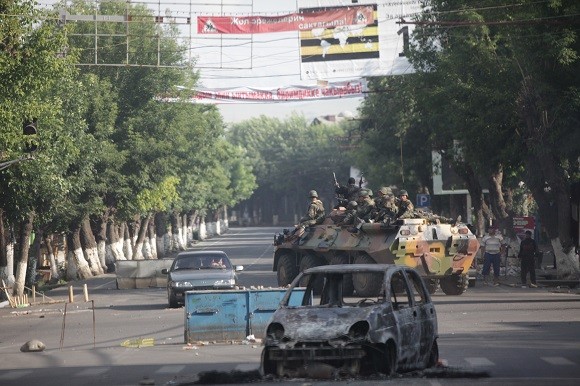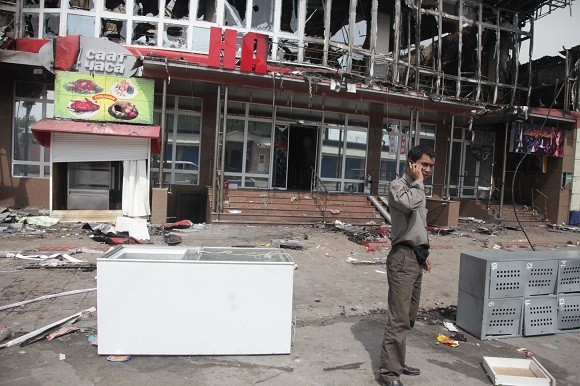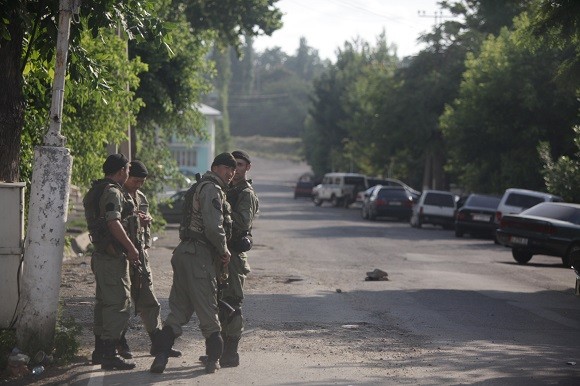 Violent rioting in the southern city of Osh in 2010, pictured here, killed more than 400 people. Image credit: Inga Sikorskaya.
Violent rioting in the southern city of Osh in 2010, pictured here, killed more than 400 people. Image credit: Inga Sikorskaya.According to the National Statistics Committee the population of the Kyrgyz Republic was nearly 6 million strong in 2014. More than two thirds of the population are ethnically Kyrgyz, but there are also significant minorities of Uzbeks and Russians, as well as Dungans and other ethnicities.
Historically, Kyrgyz and Uzbek minorities lived together in the area at the upper end of the Ferghana Valley for many centuries. This densely populated area is shared by Kyrgyzstan, Uzbekistan and Tajikistan.
After communism: politics and power struggles
Until 1990, Kyrgyzstan was part of the Soviet Union. After its collapse in 1991, the parliament elected Askar Akaev as president. He served until March 2005, when he was overthrown as a result of the Tulip Revolution.
Domestic policy in Kyrgyzstan after 1991 has been always accompanied by the struggle between the north and nouth, and relations between the regions have been disturbed by their governors. Incoming political powers often try to minimise the influence of clans.
The essence of internal conflict in Kyrgyzstan is in the struggle between various tribes for power. This struggle continues between the North, with its prevailing Chui-Issykkul clan (where the Sarybagysh tribe prevailed recently) and the South with its Osh clan.
In June 2005, Kurmanbek Bakiev, former Prime Minister, won presidential elections and ruled Kyrgyzstan until his overthrow by popular revolution in April 2010.
Revolution, tension and conflict
After the collapse of his regime and the inauguration of an interim government in 2010, Kyrgyz society lived in tension, intimidated by followers of Bakiev, who said they would seek to cause unrest. At that time the authorities sought the support of the Uzbek population in the south, to help minimise the influence of the ousted southern Bakiev clan.
In May 2010, influential southern Uzbek politician Kadyrjan Batyrov spoke to his voters and persuaded Uzbeks to take part in the political process. His speech was taken by some leaders in Kyrgyz society as a call for autonomy.
 Homes and property were destroyed during the 2010 riots, including this supermarket. Image credit: Inga Sikorskaya.
Homes and property were destroyed during the 2010 riots, including this supermarket. Image credit: Inga Sikorskaya.The nervous situation escalated into the largest armed conflict of the last twenty years, between Kyrgyz and Uzbeks residing in Osh and Jalalabad, and in some Uzbek border districts. Interethnic violence killed more than 400 people, wounded 2000, and destroyed a huge amount of mainly Uzbek property. According to international humanitarian organisations, more than one million people were involved.
In October 2011, Batyrov, who fled the country during these events, was sentenced to life in prison and confiscation of property in absentia.
Causes and consequences
Problem areas had developed prior to the violence between the Kyrgyz and Uzbeks. These included unregulated language policy and the illegal status of the Uzbek language. Politically, the Uzbeks were not satisfied with the low percentage of ethnic Uzbek representatives in the authorities and security services.
As part of the Concept of National Unity and lnter-Ethnic Relations in the Kyrgyz Republic, signed by the President Almazbek Atambaev in 2013, an action plan is being developed to strengthen interethnic harmony. It is expected to create the basis for the consolidation of society, the integration of ethnic communities, and provisions for multilingualism. But most of this is yet to become a reality. A lack of impartial evidence about what happened during the clashes, and the apparent impunity of the principal instigators and perpetrators of violence, raises difficult questions.
 Troops were put on the streets to try and keep the peace after the violence. Image credit: Inga Sikorskaya.
Troops were put on the streets to try and keep the peace after the violence. Image credit: Inga Sikorskaya.The role of local media is also important. They demonstrated their significant role both before and since the 2010 violence. According to hate speech analysis, some media in Kyrgyzstan had a powerful influence. This hate speech created negative public images of minorities, and anxiety, anger and discontent spread by the media provoked ethnic negativity and created conditions for the growth of xenophobia. This then stoked the violence.
Historical parallels
The issue served as the spark that ignited widespread violence in Osh and Uzgen in June 1990. The riots occurred over six geographical areas throughout Osh city and Osh province. 300 people died and almost 500 were seriously injured. The heaviest casualties were suffered and the most atrocious crimes were committed in and around Uzgen, where the resistance of the Uzbeks was the strongest. Soviet paratroopers were deployed within hours, with orders to use lethal force. At the end of the crisis over a thousand troops stayed for six months to keep peace and allow investigations to take place.
The parallels between the June 1990 and June 2010 events are analogous. Both outbreaks of ethnic violence occurred at a time of political confrontation, when political leaders made an attempt to replace old elites and when the central government had been weakened by political changes around it. Everyone who wants to see a peaceful Kyrgyzstan must remain vigilant, to ensure such events do not occur again.




